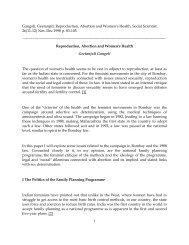Who Cares for Child Marriages? - Women's Studies Portal
Who Cares for Child Marriages? - Women's Studies Portal
Who Cares for Child Marriages? - Women's Studies Portal
Create successful ePaper yourself
Turn your PDF publications into a flip-book with our unique Google optimized e-Paper software.
<strong>Who</strong> <strong>Cares</strong> <strong>for</strong> <strong>Child</strong> <strong>Marriages</strong>?" by Shobha Saxena. Pioneer. 29 January,<br />
1999.p.10.<br />
------------------------------------------------------------------------------------------------------------<br />
<strong>Who</strong> <strong>Cares</strong> <strong>for</strong> <strong>Child</strong> <strong>Marriages</strong>?<br />
Shobha Saxena<br />
No one, finds Shobha Saxena in Rajasthan. Despite laws prohibiting such marriages,<br />
thousands of children are <strong>for</strong>ced into it. The officials are least interested to punish the<br />
guilty and the people are too callous and orthodox to change.<br />
Akha Teej or Akhsya Tritya is a time of rejoicing in Rajasthan. This is the most<br />
auspicious day <strong>for</strong> marriage. On this day practically everywhere in western<br />
Rajasthan, Bikaner, Tonk, Jhalwar, Jodhpur, and Jaiselmer, marriages are<br />
per<strong>for</strong>med en masse. Every street, house, tractor and even buses seem to<br />
reverberate with music and the cackle of gorgeously dressed marriage guests.<br />
But in all marriages the bride and the groom are children, some just two or three<br />
years old and some babies barely able to walk. These brides and grooms are<br />
carried by their parents or are perched on a thali and taken round the holy fire<br />
<strong>for</strong> per<strong>for</strong>ming the most important ceremony of their life.<br />
<strong>Child</strong> marriages are common in Rajasthan. The child brides or grooms may not<br />
understand the solemnity of these ceremonies, but <strong>for</strong> the elders it is the safest<br />
and most tested way of keeping property and money within the family. Innocent<br />
children become pawns in family businesses.<br />
Ironically child marriages are rampant in a state where the <strong>Child</strong> <strong>Marriages</strong><br />
Restraint Act, popularly known as the Sharda Act, was first conceived. Sri<br />
Harvilas Sharda, who had given concrete shape to Sharda Act, was a native of<br />
Ajmer in Rajasthan.<br />
In such unions, girls are the worse sufferers. Inadequate socialisation,<br />
discontinuation of education, great physiological and emotional damage due to<br />
repeated pregnancies devastates these girls. <strong>Child</strong> marriages increase the girl's<br />
reproductive span. Boys suffer less in this male dominated society. Most grooms,<br />
once educated and grown up, migrate to urban areas and got better jobs. Many<br />
abandon their village brides <strong>for</strong> city women. Some continue to keep two wives.<br />
In some cases the grown up boys, don't even bother to acknowledge their child<br />
marriage and the brides are <strong>for</strong>ced to go back to their parents' house.<br />
1
In case the husband dies even be<strong>for</strong>e consummation of marriage, these child<br />
brides are treated like widows. They cannot remarry and are invariably given in<br />
nata to some widower in the family. Nata is an obnoxious custom. Officially, the<br />
child is the wife of some widower but in fact she becomes the common property<br />
of all the male members of the family.<br />
Attempts to end this ancient custom were first made in 1929, when the British<br />
government, under pressure from social re<strong>for</strong>mers enacted a law against child<br />
marriages. However, the British didn't want to upset the popular traditions, so<br />
they enacted an ambivalent act called <strong>Child</strong> <strong>Marriages</strong> Restrain Act, popularly<br />
known as the Shadra Act. The Act prohibited the solemnization of child<br />
marriages but it did not declare these marriages either invalid or illegal. The Act<br />
was weak and the punishment <strong>for</strong> the offence too mild.<br />
After Independence it was realised that despite the Sharda Act child marriages<br />
continued, especially among the backward and uneducated village community.<br />
The status of women worsened with such social customs. In 1978 this Act was<br />
amended raising the age of marriage to 18 years <strong>for</strong> the girls and 21 <strong>for</strong> the boys.<br />
It also made child marriage a cognizable offence. However, it did not empower<br />
the police to prevent the marriage by arresting a person without warrant or<br />
magisterial order.<br />
Under the amended provisions of this Act the jurisdiction to take cognizance of<br />
cases of child marriage has been given to metropolitan magistrates or to judicial<br />
magistrates. They have been empowered to try any case related to child<br />
marriage. Anybody including social organisations, the police or any public<br />
spirited person can make a complaint to the police or to the magistrate directly.<br />
Acting on a complaint any court can itself make inquiries. But in practice this<br />
whole process is so complicated and so time consuming that by the time these<br />
authorities are in a position to take preventive action the marriage is already over<br />
and all proof of such a ceremony obliterated.<br />
Further, Section 12 of the amended <strong>Child</strong> Marriage Restrain Act empowers the<br />
magistrate to issue in junctions prohibiting marriages in contravention of this<br />
Act, but be<strong>for</strong>e issuing injunction the affected parties have to be given a notice to<br />
enable them to present their defence. An injunction issued without notice is not<br />
valid. This procedure is so time consuming that marriages in contravention of<br />
this Act are completed, be<strong>for</strong>e the court can pass an order preventing them. The<br />
court cannot even issue a general direction that marriage of a child shall not be<br />
solemnized within some particular time limit, say eight months or two years.<br />
The punishment under the amended <strong>Child</strong> Marriage Restraint Act remains mild,<br />
only simple imprisonment extended to three months and a fine of Rs 1000.<br />
2
According to the provisions of Section 5 of the Act whoever per<strong>for</strong>ms, conducts<br />
or directs child marriages shall be punishable. According to the interpretation by<br />
various courts these words mean working towards an end, they do not suggest<br />
arranging marriage or even attending the marriage ceremony with a view to<br />
assist the solemnization.<br />
The saddest part about child marriages is that despite the administration being<br />
fully aware of the custom, and sometimes even having advance knowledge<br />
about it, the crime against innocent children continues. As the administrators<br />
have turned a blind eye to the problem, local -people have no fear <strong>for</strong> law. Caste<br />
affinity and social pressure is so great that no one reports such cases or comes<br />
<strong>for</strong>ward to give evidence. Past experiences have taught a lesson to many, that<br />
authorities don't respond in time of such crisis.<br />
Of course, every year routine appeals <strong>for</strong> not per<strong>for</strong>ming child marriages are<br />
issued by the government and non governmental organisations. Sathins,<br />
aaganwadi workers, social organizations and the police are alerted and asked to<br />
take preventive measures. Yet the baarat with the baby groom arrives <strong>for</strong> the<br />
toddler bahu. Festivities take place in the open. The tractor trolleys with the<br />
festive people even drive past the local police stations but no action is taken by<br />
the one. How can anyone raise hue and cry over the issue. Almost everyone is<br />
equally guilty, whether it is the local MLA or the school teacher. They have either<br />
themselves married their children very young or have enthusiastically<br />
participated in such marriages.<br />
Besides administrative laxity, it is the rigidity and callousness of the local people<br />
which has led to the widespread and open practice of child marriages.<br />
The elder of any family are not willing to yield, while the youngsters and the<br />
women folk have no guts oppose them. Elders are convinced that child<br />
marriages since they are solemnized groups, are cheaper and easier to per<strong>for</strong>m.<br />
Some parents also believe that it is easier to impose their will on their children<br />
while they are still infants. They believe that once married boys do not flirt<br />
around with village girls and the girls learn to take responsibilities early in life.<br />
There is also this conviction that it is easier <strong>for</strong> the couple to adapt themselves to<br />
each other if they have known each other since childhood. Some argue that as the<br />
children stay with each other only after the girl attains puberty (gauna) there is<br />
no adverse affect on the latter’s health. But in many cases, guana is also done<br />
be<strong>for</strong>e the permitted age. The girl becomes a mother early, herself a child, she is<br />
unable to look after another child. She is crushed under multiple responsibilities<br />
of being a wife, mother and daughter-in-law. Despite growing up together, the<br />
3
oys are not completely connected or committed to their wives and some even<br />
seek relationships outside marriage.<br />
Sadly, these people fail to appreciate the basic fact that each child is an<br />
individual, with different likes and dislikes which depend on the environment,<br />
experience and education the child has undergone.<br />
Moreover, people in Rajasthan jealously guard their customs and traditions.<br />
They fail to appreciate that the social and political conditions that created these<br />
customs have become extinct. In earlier days travelling to religious places and<br />
coming back safe was an achievement. So, when people returned safely from<br />
pilgrimages, marriages of daughters was considered auspicious. Since friends<br />
and relatives had already gathered, match making became easier. Thus a custom<br />
developed to celebrate marriages after returning from a pilgrim. Similarly, it was<br />
considered auspicious to marry a girl child on the death of some elderly person<br />
in the family. Today in the garb of social customs, families damage, their own<br />
children only to strike better financial deals <strong>for</strong> the future.<br />
The malaise is so deep rooted that mere vocal condemnation of the practice won't<br />
do. What is needed is consistent and planned campaign against child marriages.<br />
The campaign should not operate only during Akha Teej. The patvari, sarpanch<br />
and the police should be vigilant throughout. Both the government and nongovernment<br />
organisations need to coordinate to draw a long term strategy. The<br />
campaigners need to identify the opinion builders of the community. Until and<br />
unless these leaders make people realise the cruelty they are inflicting on their<br />
own children, the crimes will not stop.<br />
4

















